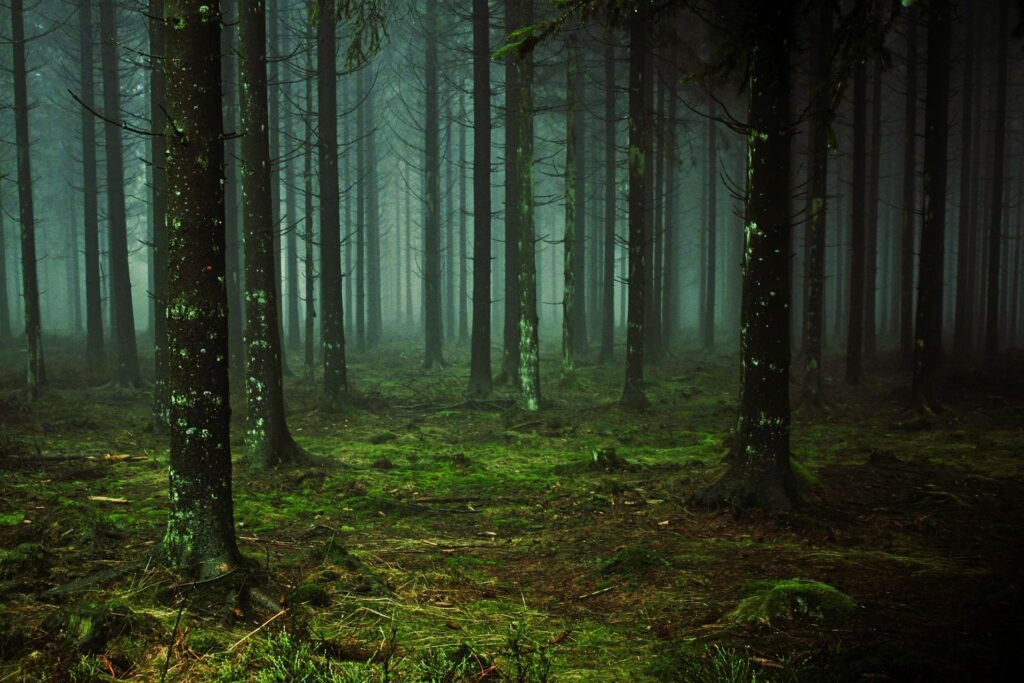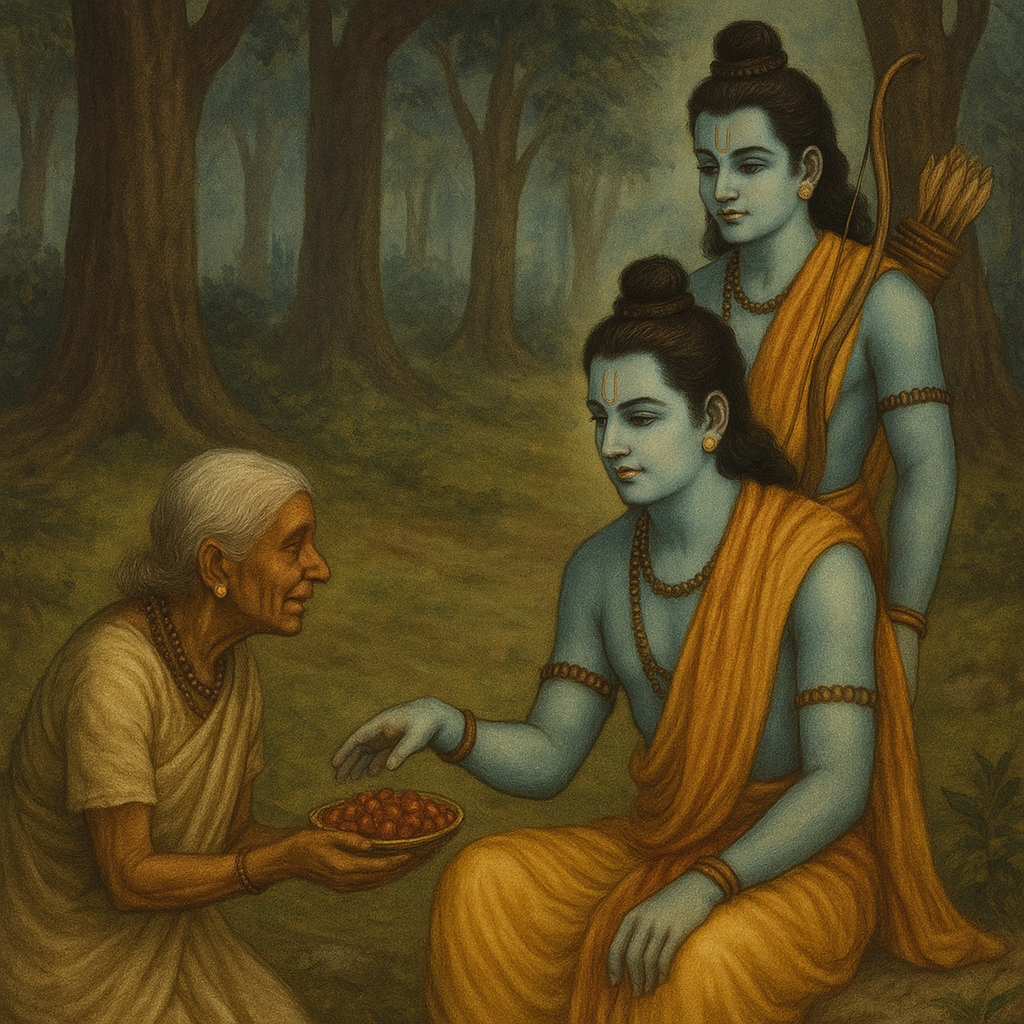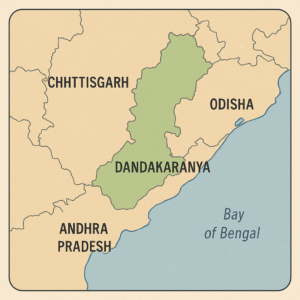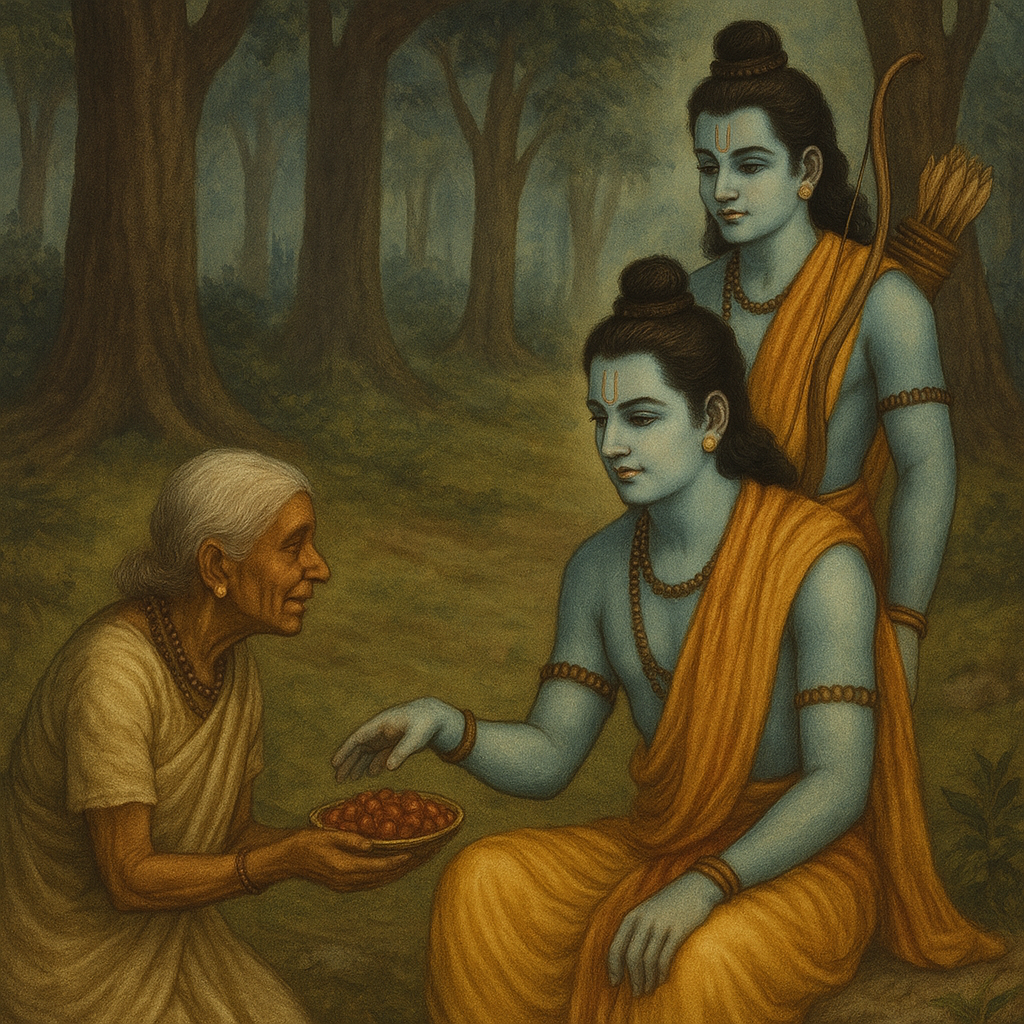A Forgotten Curse That Still Haunts India?
Imagine wandering into an ancient forest, where time seems to stand still. The air is thick with the scent of earth and damp leaves, and a strange silence engulfs the towering trees. The deeper you go, the more unsettling it becomes—almost as if someone, or something, is watching you. Locals warn you not to venture too far, for those who disrespect this land are said to meet an unfortunate fate.

This is Dandakaranya, a dense and mysterious forest that has been shrouded in legends for centuries. It is believed to be the very place where Mata Shabari, the devoted disciple of Lord Rama, once lived. Her story is one of pure devotion, but hidden beneath the layers of reverence is a lesser-known tale—a tale of an ancient curse.
Yes, you heard that right. While most of us know about Shabari’s unwavering faith, few are aware of the curse she left behind before attaining moksha (liberation). According to folklore, anyone who disrespects her sacred land is doomed to suffer misfortune, illness, or even death. Some claim it’s just a myth. Others swear they’ve witnessed its eerie effects firsthand.
But is there any truth to this chilling legend? Or is it just another folktale, passed down through generations?
In this blog article, we’ll unravel the mystery of Mata Shabari’s curse, diving deep into its origins, its connection to the Ramayana, and the eerie incidents reported by those who dared to challenge it. Whether you’re a lover of mythology or just someone who enjoys a good ghost story, you’re in for a thrilling ride!
So, are you ready to explore one of India’s most intriguing, yet forgotten, curses? Let’s begin!
Table of Contents
Who Was Mata Shabari? A Symbol of Unwavering Devotion
Before we dive into the mystery of her curse, let’s first understand who Mata Shabari was and why she holds such an important place in Hindu mythology.
If you’ve read or heard stories from the Ramayana, you might recall the moment when Lord Rama, in search of Sita, arrives at a humble hut in the middle of a forest. There, he meets an elderly woman—Shabari, a simple tribal devotee who had been waiting her entire life for Him. Her devotion was so pure that she offered him wild berries, carefully tasting each one to ensure they were sweet. While this act might seem insignificant, it carried a profound spiritual meaning—love and faith transcend social status, caste, and rituals.
But there’s more to her story than just this touching moment.
Shabari’s Early Life: A Woman Ahead of Her Time
Shabari wasn’t born into a privileged family. She was a Bhil tribal woman, part of an indigenous forest-dwelling community. In ancient times, caste divisions were strict, and tribal people were often marginalized. But Shabari was different—she had a deep spiritual thirst and longed to break free from the limitations society placed upon her.
Legend has it that on the night before her wedding, she witnessed a horrific sight—thousands of animals being sacrificed as part of wedding rituals. Horrified and disillusioned, she fled her home, choosing a life of devotion over one of tradition and social norms.
Her journey led her to the hermitage of Sage Matanga, a revered rishi who recognized her spiritual potential. Despite her humble origins, she became one of his most dedicated disciples, spending years in his ashram, performing seva (selfless service) and engaging in deep meditation.
But her ultimate goal was not just spiritual knowledge—it was to meet Lord Rama.
The Wait for Lord Rama: A Lifetime of Faith
Sage Matanga, before leaving his mortal body, assured Shabari that one day, Lord Rama would visit her. Trusting his words completely, she spent years preparing for His arrival. Every single day, she:
- Swept the path leading to her hut, so Rama wouldn’t step on thorns.
- Collected wild berries, testing them for sweetness before saving the best for Him.
- Decorated her humble dwelling, believing that any moment could be the one when He finally arrived.
Despite growing old, her faith never wavered. And then, one day, it happened.
The Divine Meeting: When Love and Devotion Defeated Caste
When Lord Rama and Lakshmana arrived at her hut, Shabari was overwhelmed with joy. She washed their feet, welcomed them with folded hands, and humbly offered them berries—berries she had already tasted to ensure their sweetness.

Now, according to social norms, this was unacceptable—how could a tribal woman offer half-eaten food to the prince of Ayodhya? But Rama, being the embodiment of compassion and love, gladly accepted her offering, stating that it was the purest food He had ever tasted.
In that moment, Shabari attained moksha (liberation), as Lord Rama blessed her for her unparalleled devotion. Many believe she merged with the divine right then and there, leaving behind a powerful legacy of faith and surrender.
But here’s where the mystery begins.
While most versions of the Ramayana end her story at this divine meeting, some regional legends suggest Shabari stayed behind and continued her spiritual practices. However, before leaving her mortal body, she uttered a powerful curse—one that would change the fate of her beloved Dandakaranya forest forever.
But why? And whom did she curse?
Let’s uncover the darkest chapter of her legend—the curse of Mata Shabari.
The Legend of Mata Shabari’s Curse: A Forest Doomed by Divine Wrath
Now that we know about Mata Shabari’s unwavering devotion, let’s dive into the mystery of her curse—a lesser-known legend that has haunted Dandakaranya Forest for centuries.
Why Would a Devotee Like Shabari Utter a Curse?
At first, it seems unthinkable. Why would a saintly woman, who embodied love and faith, leave behind a curse? Wouldn’t her soul, after being blessed by Lord Rama, be at peace?
Well, the answer lies in what happened after Rama left.
According to certain regional folktales, Shabari, though liberated in spirit, remained in her physical form for some time. She continued to live in Dandakaranya, meditating and spreading spiritual wisdom. But after Lord Rama’s departure, things began to change—and not for the better.
The Betrayal: When Greed Invited Wrath
Once Lord Rama left, Dandakaranya became a place of pilgrimage. Thousands of sages, seekers, and devotees started visiting the region, hoping to attain the same spiritual enlightenment that Shabari had. However, not all came with pure intentions.
As time passed, outsiders began exploiting the sacred land. They cut down trees, hunted animals, and even looted places that were once used for meditation and prayer. The same forest where Shabari had patiently waited for Rama for years was now being polluted with greed and disrespect.
Seeing the desecration of her beloved land, Shabari’s heart was filled with sorrow. She had dedicated her entire life to making Dandakaranya a sanctuary of devotion, and now, it was being destroyed by selfishness and ignorance.
And that’s when, according to legend, she uttered her final words—a powerful curse.
The Curse of Mata Shabari
As the story goes, in her final moments, Shabari called upon divine forces and spoke these words:
“The land that once thrived in devotion shall now become a land of fear. Those who come here with greed in their hearts shall find only misfortune. Those who dishonor this sacred place shall never find peace. This forest shall remain a land of wandering spirits—restless, tormented, and unseen.”

With that, a strange silence fell over the forest. The winds grew still, the birds stopped chirping, and a chilling aura settled over the land. Some say that Shabari’s soul left her body at that very moment, merging into the divine—but her curse remained.
And from that day on, Dandakaranya was never the same.
The Aftermath: A Land Cursed with Strange Phenomena
Over the centuries, locals and travelers alike have reported eerie incidents in and around Dandakaranya. Some of the strangest occurrences include:
- Unexplained Disappearances: Many people who entered the dense forest alone have vanished without a trace, never to be seen again.
- Haunting Voices: Several visitors have claimed to hear whispers in the wind, as if unseen forces are trying to communicate—or warn them.
- Sudden Illnesses: Those who disrespected the land—by cutting trees, hunting, or looting—have suffered from mysterious fevers, hallucinations, and even paralysis.
- Restless Spirits: Locals believe that those who died within the cursed land never find peace. They say the spirits of wrongdoers remain trapped, forever wandering.
Even today, villagers warn against entering Dandakaranya after sunset. Some claim to have seen shadowy figures moving between the trees, while others speak of an unseen presence that watches every step.
Is the Curse Real? Or Just a Myth?
Skeptics argue that these stories are just folktales meant to keep people from disturbing the forest. After all, every ancient place has its legends, right?
But then, how do you explain the strange experiences reported by so many people?
Could it be that Shabari’s words still hold power, even centuries later? Or is it just our fear of the unknown playing tricks on our minds?
Regardless of what you believe, one thing is certain—Dandakaranya is not an ordinary place. It holds centuries of devotion, mystery, and perhaps… an ancient curse that still lingers in the wind.
But the real question is:
Would you dare to visit and find out for yourself?
The Mystery Continues: Tales of Those Who Challenged the Curse
Legends and myths are fascinating, but what makes them truly chilling is when people claim to have experienced them firsthand. Over the years, several strange incidents have been reported in and around Dandakaranya, making even skeptics question whether Mata Shabari’s curse is real.
Here are some of the most spine-chilling stories from those who dared to challenge the forbidden land.
1. The Disappearance of the Three Travelers (1982)
One of the most famous cases linked to Shabari’s curse is the mysterious disappearance of three friends in 1982.
According to local accounts, a group of young men from a nearby village decided to test the legend. They entered Dandakaranya at night, carrying torches and laughing off the villagers’ warnings.
But they never returned.
A search party was sent the next morning, and what they found sent shivers down their spines—
- Their campfire was still burning, but the men were nowhere to be seen.
- Their belongings—bags, shoes, even a half-eaten meal—were untouched.
- No footprints, no signs of struggle, nothing. It was as if they had simply vanished into thin air.
Even to this day, no one knows what happened to them. Did they lose their way? Did they fall into a hidden pit? Or did Shabari’s curse take them? No one can say for sure.
But after this incident, villagers strictly prohibited nighttime visits to the forest.
2. The Man Who Cut Down a Tree (1997)
In 1997, a woodcutter named Ramesh Tiwari ignored the warnings of his elders and entered the forest to cut wood for selling. He laughed at the idea of a curse, saying,
“It’s just a forest! What’s the worst that could happen?”
But what followed changed his life forever.
Ramesh successfully chopped down a large, old tree near a small pond in the forest. But as soon as the tree hit the ground, he felt an unbearable heat surrounding him. The air became thick and suffocating, and he claimed to hear a woman whispering in an unknown language.
Terrified, he ran back to his village, leaving his tools behind. But the horror didn’t end there.
- That very night, he fell ill with a severe fever.
- He started having nightmares of a shadowy woman standing near his bed, staring at him.
- His health deteriorated rapidly, and within a week, he lost his ability to walk.
Desperate, his family consulted a local priest, who advised them to perform a ritual in Shabari’s honor and apologize for disturbing the land. They followed his instructions, and miraculously, Ramesh began recovering.
Was it coincidence? Or did he truly experience the wrath of Shabari’s curse?
3. The Tourists Who Mocked the Legend (2015)
In 2015, a group of college students from Delhi visited Dandakaranya as part of an adventure trip. They had heard the stories of Mata Shabari’s curse but considered them superstitions meant to scare people.
One of the students, Amit, decided to challenge the legend openly. He recorded a video where he mocked the curse, saying:
“If Shabari is really here, let her show herself!”
They laughed and continued their trek. But within an hour, Amit started feeling uneasy. He complained about a burning sensation in his chest and felt as if something was pulling him backward.
By evening, Amit had developed a high fever, and his body was covered in red marks—as if he had been scratched by invisible claws. He had to be rushed back to the city, where doctors found no medical explanation for his condition.
His friends, shaken by the incident, deleted the video and never spoke about it again.
What Do These Stories Tell Us?
Are these just coincidences, or is there truly something lurking in Dandakaranya?
Skeptics argue that the disappearances and illnesses could have logical explanations—getting lost, dehydration, hallucinations, or even psychological fear amplifying small events.
But believers claim that too many incidents have happened for it to be a mere coincidence. Something protects this land, and anyone who disrespects it faces the consequences.
One thing is certain—no one leaves Dandakaranya untouched. Whether it’s a mere unsettling feeling or an outright paranormal encounter, something lingers in the air, whispering a warning to those who dare to enter.
Would you take the risk?

